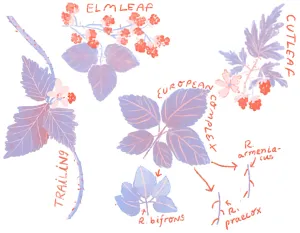Native West Coast Woodland Rose
Got a shady corner in your garden that needs a touch of beauty? Planning a food forest or embarking on ecological restoration in a West Coast woodland? Meet Baldhip Rose, your new best friend.
I was thrilled when I first stumbled upon this diminutive rose. In my yard's wooded area, it's often smaller than its other PNW native counterparts, with dainty leaves and small blooms. It's clear why this plant is also called "Dwarf Rose"!
But don’t let its size fool you—this plant is surprisingly well-equipped with prickles. They might be termed "weak," but their abundance is quite a sight!
Before this discovery, I assumed all roses needed full sun to truly flourish. Imagine my surprise when I noticed these resilient roses thriving under the shady canopy of my wild landscape.
In this article, I’ll guide you through the key features to identify Baldhip Rose confidently. Here, I've created visual tools designed to enhance your identification skills, plus insights into its ecological role and historical significance in the Pacific Northwest.
Baldhip Rose: Native Understory Plant of the West Coast
Sources: Bellevue Botanical Garden; iNaturalist; Pavek, P.L.S. and D.M. Skinner. 2013. Plant guide for baldhip rose (Rosa gymnocarpa Nutt.). USDA Natural Resources Conservation Service, Pullman, WA; Ertter, B., & Lewis, W. H. (2016). RELATIONSHIPS, INFRATAXA, AND HYBRIDS OF ROSA GYMNOCARPA (ROSACEAE). Madroño, 63(3), 268–280. visual guide to Dwarf Wood Rose
Practical Guide: How to Identify Rosa Gymnocapa in the Wild
Mastering the identification of wild roses in the Pacific Northwest is vital for ecological stewardship.
While the region boasts native wild roses like Rosa gymnocarpa, invasive species like Dog Rose and Sweetbrier pose a challenge. These species intrude on our local ecosystem and displace native plants. This changes our habitats in a way that decreases biodiversity.
Native Baldhip Rose enhances the region's landscape. It's a top choice for woodland conservation efforts, since it provides habitats for native wildlife.
This guide offers visual tools to help you distinguish between our native species and invasive threats, safeguarding our local ecosystems for ecologists and conservationists alike
Sources: Pavek, P.L.S. and D.M. Skinner. 2013. Plant guide for baldhip rose (Rosa gymnocarpa Nutt.). USDA Natural Resources Conservation Service, Pullman, WA; Ertter, B., & Lewis, W. H. (2008). NEW ROSA (ROSACEAE) IN CALIFORNIA AND OREGON. Madroño, 55(2), 170–177; Ertter, B., & Lewis, W. H. (2016). RELATIONSHIPS, INFRATAXA, AND HYBRIDS OF ROSA GYMNOCARPA (ROSACEAE). Madroño, 63(3), 268–280. Close-up of a single leaflet on one of the baldhip rose plants in my yard - notice how the larger serrations have smaller serrations within them? an extreme example of a inverse-ovate leaflet shape on one of my backyard baldhip roses
Comparison Chart: Baldhip Rose vs. Other PNW Roses
Sources: Madroño 1; Madroño 2; Barbara Ertter 2014, Rosa pisocarpa, in Jepson Flora Project (eds.) Jepson eFlora, Revision 2, Klinkenberg, Brian. (Editor) 2020. E-Flora BC: Electronic Atlas of the Plants of British Columbia. Lab for Advanced Spatial Analysis, Department of Geography, University of British Columbia, Vancouver.One of the easiest visual component of the baldhip rose to help with ID is its hip/fruit. You can see the sepals have fallen cleanly off of this one from my wooded area
Small but important: The Ecological Benefits of Baldhip Rose
For a long time, I was a little overwhelmed by the variety within the wild roses of the PNW. I could spot a rose, but identifying it beyond that was a challenge for me.
This perspective shifted when I encountered a unique rose nestled near a shaded trail behind my home. There, amidst the dappled light of Douglas Fir trees, was a Baldhip Rose, its branches adorned with an arsenal of straight thorns.
In delving deeper into the Rosa genus, I discovered that this quiet yet steadfast plant was the Rosa gymnocarpa—Baldhip Rose. It became the first of our roses that I could identify with confidence.
While it doesn't boast the showy displays of its cultivated cousins or the local fame of the Nootka Rose, it quietly thrives in the understory, maybe a bit of an introvert, which may be why it wins a place in my heart.
But why should you take notice of this understated rose when the world is full of bold, mesmerizing blooms?
Ecological Significance
Wildlife Food Source
According to the Washington Native Plant Society and the East Multnomah SWCD, there are several native animal species who enjoy Dwarf Wood Rose as a food source.
- Grouse
- Bluebirds
- Juncos
- Grosbeaks
- Quail
- Pheasants
- Thrushes
- Mourning Cloak Butterfly Larvae
- Gray Hairstreak Butterfly Larvae
- Anise Swallowtail Butterflies (nectar)
- Hummingbirds (nectar)
- Leaf-cutter Bee
- Chipmunks
- Rabbits
- Porcupines
- Coyotes
- Deer
- Elk
- Bear
Interestingly, the seeds are a source of grit for birds, which helps them to digest food properly.
Wildlife Habitat
WNPS and EMSWCD also note that Rosa gymnocarpa provides the ecosystem service of habitat and shelter.
- Pheasants
- Grouse
- Small mammals
- Pollinators (overwinter inside stems)Baldhip rose in bloom
Baldhip Rose: An Essential Native Plant for West Coast Ecosystems
As we protect these delicate roses, we write ourselves into the story of our natural world. Let’s embrace the journey with wonder, curiosity, and a commitment to conservation.
This adventure is not just about discovering a plant; it's about connecting with the intricate web of life in which we all play a part. Understanding and identifying the wild roses of the Pacific Northwest empowers you to actively participate in ecological preservation. So, arm yourself with knowledge, step into the wilderness, and let’s bloom together in stewardship of our cherished wild roses.
Click here to learn more about the roses that you can find growing wild in the PNW!




